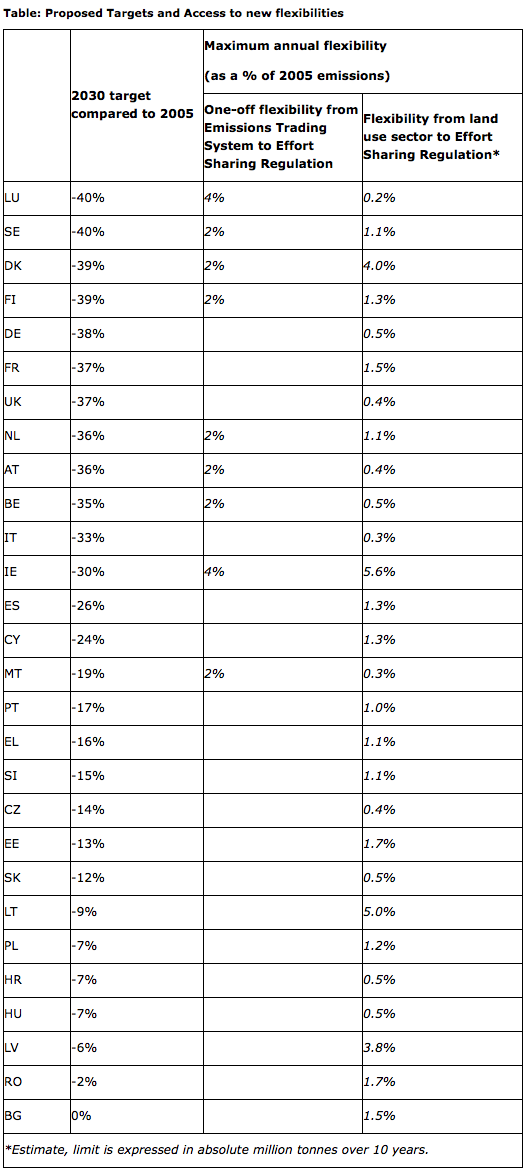Europese Commissie verdeelt CO2-reductie voor 2020-2030 over de lidstaten. Nederland van 16% naar 36%
20 juli 2016 – Vandaag is de Europese Commissie voor de jaren 2020-2030 met een voorstel gekomen voor de verdeling van de CO2-reductiedoelstellingen over de lidstaten. Nederland moet duidelijk meer doen dan nu: 36% reductie voor de sectoren transportsector, landbouw, bebouwde omgeving en afval.
In 2014 was overeengekomen dat de hele EU per 2030 40% minder CO2 zou uitstoten (ten opzichte van 2005).
In de ronde die nu loopt (tot 2020) moet de EU een reductie van 20% zien te bereiken. Nederland staat nu voor 16% aan de lat en dat gaat voor de periode van 2020-2030 naar 36%.
Het (nog goed te keuren) voorstel van de Europese Commissie rept met geen woord over de twijfels die van verschillende kanten zijn geuit over de haalbaarheid van de reductiepercentages. Wel zegt de EC dat de nieuwe plannen aansluiten bij het Akkoord van Parijs.
De Commissie ziet het voorstel ook als een verdere vormgeving van de Energie Unie.
Bindende doelen voor sectoren
De ‘bindende doelen’ richten zich met name op een aantal sectoren: transport, gebouwde omgeving, landbouw, afval, landgebruik en bosbouw.
Zero-emission en low-emission wordt een speerpunt voor de mobiliteit (waarvoor een speciaal Actie Plan komt).
Een andere belangrijk speerpunt wordt de herziening van het Emissions Trade System (ETS).
De uitgangspunten van het hele pakket zijn: ‘fairness, solidarity, cost-effectiveness and environmental integrity’. En het geldt voor alle lidstaten (de gevolgen van een Brexit zijn nog niet meegenomen): ‘All Member States are concerned, as they will be in the forefront in deciding how to implement the measures to meet the agreed 2030 target.’
Uit het persbericht van de Europese Commissie
‘(…) Maroš Šefčovič
Vice-President in charge of the Energy Union Maroš Šefčovič said: “The Energy Union is delivering. With the proposed reform of the Emissions Trading System last year and today’s proposal on greenhouse gas emissions targets for Member States, we anchor the 2030 Energy and Climate framework in legislation. We are also setting our transport system firmly on the path towards zero-emissions. Today’s package shows that we are mobilising all our policies towards the competitive, circular and low-carbon economy that we promised in the Energy Union Strategy”.
Jyrki Katainen
Vice President for Jobs, Growth, Investment and Competitiveness Jyrki Katainen said: “This strategy is more than about transport and emissions. It should be seen as yet another element of our efforts to modernise European economy and strengthen our Internal Market. It defines key priorities on the way to low-emission mobility and gives clear guidance for future investors. It contributes to our goals which do not change over time – we want to create conditions for our industry to be more competitive and able to provide quality jobs.”
Miguel Arias Cañete
EU Commissioner for Climate Action and Energy Miguel Arias Cañete said: “The EU has an ambitious emissions reduction target, one I am convinced we can achieve through the collective efforts of all Member States. The national binding targets we are proposing are fair, flexible and realistic. They set the right incentives to unleash investments in sectors like transport, agriculture, buildings and waste management. With these proposals, we are showing that we have done our homework and that we keep our promises.
Violeta Bulc
EU Commissioner for Transport Violeta Bulc said: “Transport accounts for a quarter of Europe’s greenhouse gas emissions and is a main cause of air pollution. The transition to low-emission mobility is therefore essential to reach the EU’s ambitious climate objectives and to improve the quality of life in our cities. It is also an opportunity to modernise the EU’s economy and keep Europe’s industry competitive. The Strategy we adopted today presents a roadmap towards low-emission mobility and will give an impetus to that shift.”
Financial
In the EU, efforts have already started to align private investments with climate and resource-efficiency objectives. The EU financial instruments are significant contributors to climate funding. Over 50% of the investments approved so far are climate relevant. As part of the Investment Plan for Europe, the European Fund for Strategic Investments is on track to deliver on mobilising at least EUR 315 billion in additional investment in the real economy by mid-2018. In addition, the Commission actively works to ensure that the EU budget spending is aligned with climate objectives. At least 20% of the current EU budget is explicitly climate related. (…)’

Bronnen
Europese Commissie, 20 juli 2016: Energy Union and Climate Action: Driving Europe’s transition to a low-carbon economy
Regulation of the European Parliament and of the Council (pdf, 38 pag.)
Annexis to the Proposal for a Regulation of the European Parliamemnt and of the Council (pdf, 4 pag.)



